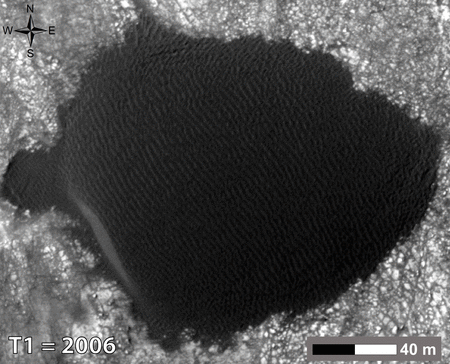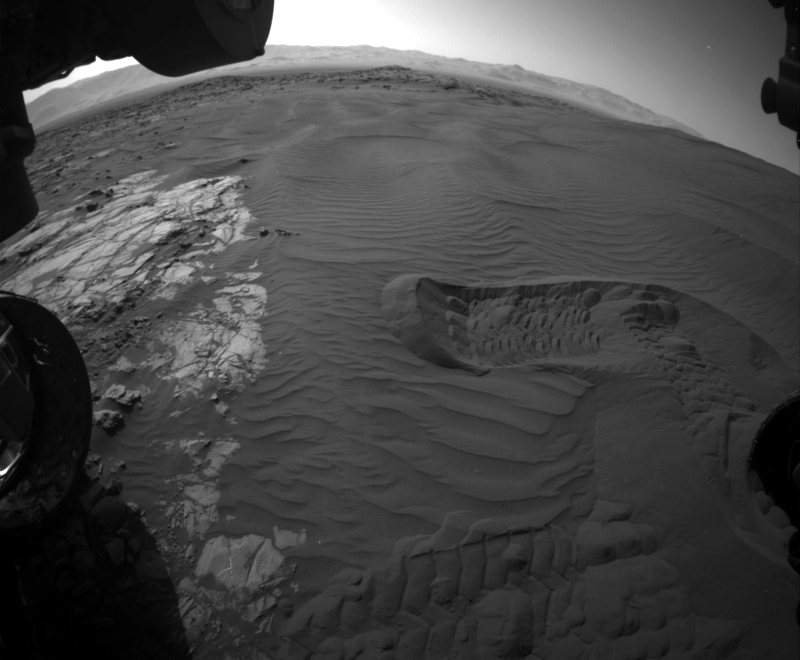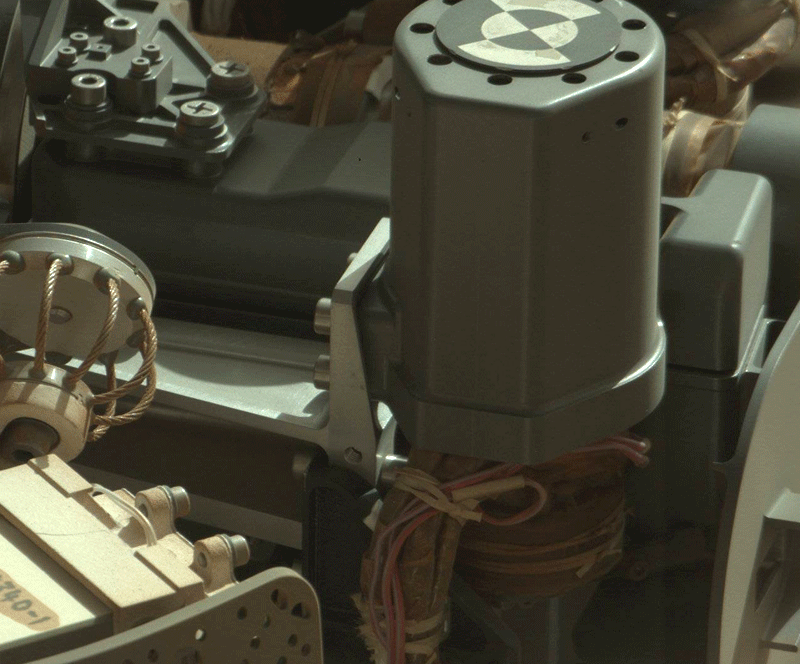Curiosity rover explores dark dunes

For two long years, Curiosity did not dare to approach Mount Sharpe, although he was sent to study it. Deposits of dark sand interfered with the path, so they had to be avoided. The rover moved along the mountain, and black dunes loomed constantly at the foot, sometimes resembling a frozen sea, sometimes an old highway.
The longer they sailed in the distance, the more they wanted to get closer to them, look at the MAHLI macro camera, touch the APXS spectrometer, start the bucket in them, roast them in the microwave of a SAM chromatograph and illuminate with a CheMin X-ray diffractometer .

Since the summer of 2013, the Mars rover has been moving along a dark dune spit to a gap in the sand, where on hard ground it was possible to get to the mountain slopes and the canyon, which was once cut through the mountain by meltwater streams. While Curiosity was far from a scientist, we had to be content with high-resolution satellite images of the MRO HiRise camera. Pictures of this camera transmit the image in "advanced" colors, in which the dark sand seemed blue, or greenish.

In part, this effect is not accidental. The CRISM satellite hyperspectrometer showed a high content of volcanic minerals pyroxene and olivine. Pyroxene is responsible for almost all the dark rocks of Mars that are observed from space. It is the pyroxene "seas" that look like dark spots when viewed through a telescope.
The dark blue dunes of Mars acquire blue-green hues thanks to olivine - also a volcanic rock, which got its name, for its green color, like that of olives.
In the first months of Curiosity's stay in Gale Crater, the question of the density of these sands remained. Are they a long petrified monolith that retains the shape of an ancient desert (or the seabed), or are they ordinary sand? At first, the engineers did not dare to call in and feel the wheel of the rover, so as not to waste time. But the dunes began to be observed from the satellite, and compared with the images that were taken four years before the landing of Curiosity. And the answer was received - they are "alive".

The moving dunes in Gale Crater are not unique to Mars. Scientists have been observing dunes in several regions of the planet for several years.
Here it must be clarified that dust storms are frequent on Mars, but not sandstorms. The difference in size and mass of particles. The thin atmosphere and gentle wind are able to raise fine dust high, and the sand can only be moved by centimeters, as a result of which the dunes crawl about a meter per year.
The isolated position of these dunes from other sand and dust is explained by the size, mass, and possibly the shape of the particles. Despite the fact that they seem to be gathered and held together by some kind of magical power, when viewed from above, it is clear that the dark sands spread quite far from the dunes, and paint the terrain on the approaches in dark tones.
This partly explains why from afar the dunes stood out sharply from the surrounding countryside, and as they approached, the contrast decreased. The “black-blue / white-gold” effect is also possible.

While Curiosity walked around the mountain, its movement was relatively frisky, by Mars roaming standards — about 6 kilometers a year. When his course changed and a gradual rise began , the speed of advance sharply decreased due to long stops for a detailed survey of soils.
Mount Sharpe has attracted the attention of scientists for a long time due to its layered structure . Curiosity's upward movement, with the analysis of all geological layers - this is his priority, for which he flew here. Therefore, the remaining two kilometers from the foot to the dune fields had to wait another year.
Finally, we are here!

On the desktop.
Dune scythe stretching by the mountain, called the Dunes of Bagnold, in honor of the explorer of the Sahara. The next two piles of sand, which Curiosity undertook to study, were called Namib, in honor of the earthly desert.
The last half a kilometer to the dunes of Namib, the drivers of the rover themselves seemed to be in a hurry, wanting to quickly examine the dark dumps. However, the rush did not prevent them from discovering interesting deposits of soil with a high silicon content along the way. How he postponed there remains to be seen, and Curiosity has already moved to the study of sand.
Having thrown off the collected soil with a high silicon content, the rover created an entertaining still life of three “varieties” of Mars: the gray-blue soil mined by the drill from a depth of 5 cm lay on solid sedimentary rocks covered with a layer of light red dust. A scree of dark sand is visible nearby, alarmed by the rover wheels.

Dark sand was examined with a MAHLI macro camera.

For comparison, we can recall the deposits of other sand - red, which was studied by the rover in the first year of its expedition.

It can be seen that dark sand with a more “granular” particle size is approximately the same, with interspersed larger ones. Red sand consists of two fractions - relatively large grains of sand mixed with dust (more precisely, siltstone - a transitional form between dust and sand).
The difference in the physical properties of the sand explains the fact that the dark and red dunesdo not mix. Although the behavior of sand interacting with the wind is now the leading direction in research, and many more are unknown. The rover can stand in one place for several months only to see, from the surface, how the dunes crawl.

At first, Curiosity crept up to a small depression filled with dark sand. Here, primary research was carried out, and it became clear that the dunes here are the most ordinary, with no signs of petrification. Then the rover moved to a more impressive dune, several meters high. First, a careful examination was made, and then Curiosity unceremoniously disturbed the calm of the dunes and dug a small trench with its wheel.
This place was recognized as promising enough to begin the in-depth study of samples. The rover used his bucket to take three soil samples in turn.

In the process, Curiosity made a self-portrait, which can be viewed on an impressive panorama, which was shot by a camera on the rover's manipulator and brought into an interactive panorama by photo artist Andrei Bodrov.

The first samples were sent to a SAM laboratory device to determine the chemical and isotopic composition of sand minerals.
But then a problem arose: the Chimra tool seems to be stuck, which is located in the manipulator and is used to sift the soil. Screening soil is a necessary procedure before loading samples into internal laboratory instruments. Examination by instruments is possible only of small particles of not more than 0.15 mm. To weed out extra, larger grains of sand, Chimra is used - it is a set of several cavities and gratings with different cell sizes that allow you to clean the soil to the required levels.

The malfunction arose after Curiosity for the third time scooped up dark sand with a bucket and was about to prepare it for research. Due to the Chomra "anomaly," the rover stopped exploring the sand of the dark dune and continued to study the surroundings with the help of APXS and ChemCam spectrometers.
It is too early to say how malfunctioning can harm the scientific mission of the rover and when it will be possible to cope with it. Previous experience shows that engineers are creative in overcoming such difficulties, but even the reason for the failure is not yet known, so we can only wait and hope for the best.
About what are the results of the study of dark sand, its composition and possible origin, we also find out later, when geologists finish processing the results.
